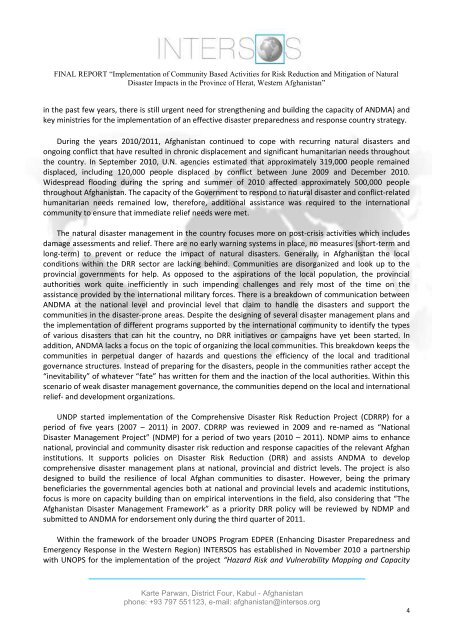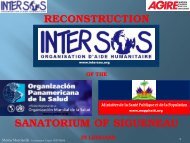Implementation of Community Based Activities for Risk ... - Agire
Implementation of Community Based Activities for Risk ... - Agire
Implementation of Community Based Activities for Risk ... - Agire
You also want an ePaper? Increase the reach of your titles
YUMPU automatically turns print PDFs into web optimized ePapers that Google loves.
FINAL REPORT “<strong>Implementation</strong> <strong>of</strong> <strong>Community</strong> <strong>Based</strong> <strong>Activities</strong> <strong>for</strong> <strong>Risk</strong> Reduction and Mitigation <strong>of</strong> NaturalDisaster Impacts in the Province <strong>of</strong> Herat, Western Afghanistan”in the past few years, there is still urgent need <strong>for</strong> strengthening and building the capacity <strong>of</strong> ANDMA) andkey ministries <strong>for</strong> the implementation <strong>of</strong> an effective disaster preparedness and response country strategy.During the years 2010/2011, Afghanistan continued to cope with recurring natural disasters andongoing conflict that have resulted in chronic displacement and significant humanitarian needs throughoutthe country. In September 2010, U.N. agencies estimated that approximately 319,000 people remaineddisplaced, including 120,000 people displaced by conflict between June 2009 and December 2010.Widespread flooding during the spring and summer <strong>of</strong> 2010 affected approximately 500,000 peoplethroughout Afghanistan. The capacity <strong>of</strong> the Government to respond to natural disaster and conflict-relatedhumanitarian needs remained low, there<strong>for</strong>e, additional assistance was required to the internationalcommunity to ensure that immediate relief needs were met.The natural disaster management in the country focuses more on post-crisis activities which includesdamage assessments and relief. There are no early warning systems in place, no measures (short-term andlong-term) to prevent or reduce the impact <strong>of</strong> natural disasters. Generally, in Afghanistan the localconditions within the DRR sector are lacking behind. Communities are disorganized and look up to theprovincial governments <strong>for</strong> help. As opposed to the aspirations <strong>of</strong> the local population, the provincialauthorities work quite inefficiently in such impending challenges and rely most <strong>of</strong> the time on theassistance provided by the international military <strong>for</strong>ces. There is a breakdown <strong>of</strong> communication betweenANDMA at the national level and provincial level that claim to handle the disasters and support thecommunities in the disaster-prone areas. Despite the designing <strong>of</strong> several disaster management plans andthe implementation <strong>of</strong> different programs supported by the international community to identify the types<strong>of</strong> various disasters that can hit the country, no DRR initiatives or campaigns have yet been started. Inaddition, ANDMA lacks a focus on the topic <strong>of</strong> organizing the local communities. This breakdown keeps thecommunities in perpetual danger <strong>of</strong> hazards and questions the efficiency <strong>of</strong> the local and traditionalgovernance structures. Instead <strong>of</strong> preparing <strong>for</strong> the disasters, people in the communities rather accept the“inevitability” <strong>of</strong> whatever “fate” has written <strong>for</strong> them and the inaction <strong>of</strong> the local authorities. Within thisscenario <strong>of</strong> weak disaster management governance, the communities depend on the local and internationalrelief- and development organizations.UNDP started implementation <strong>of</strong> the Comprehensive Disaster <strong>Risk</strong> Reduction Project (CDRRP) <strong>for</strong> aperiod <strong>of</strong> five years (2007 – 2011) in 2007. CDRRP was reviewed in 2009 and re-named as “NationalDisaster Management Project” (NDMP) <strong>for</strong> a period <strong>of</strong> two years (2010 – 2011). NDMP aims to enhancenational, provincial and community disaster risk reduction and response capacities <strong>of</strong> the relevant Afghaninstitutions. It supports policies on Disaster <strong>Risk</strong> Reduction (DRR) and assists ANDMA to developcomprehensive disaster management plans at national, provincial and district levels. The project is alsodesigned to build the resilience <strong>of</strong> local Afghan communities to disaster. However, being the primarybeneficiaries the governmental agencies both at national and provincial levels and academic institutions,focus is more on capacity building than on empirical interventions in the field, also considering that “TheAfghanistan Disaster Management Framework” as a priority DRR policy will be reviewed by NDMP andsubmitted to ANDMA <strong>for</strong> endorsement only during the third quarter <strong>of</strong> 2011.Within the framework <strong>of</strong> the broader UNOPS Program EDPER (Enhancing Disaster Preparedness andEmergency Response in the Western Region) INTERSOS has established in November 2010 a partnershipwith UNOPS <strong>for</strong> the implementation <strong>of</strong> the project “Hazard <strong>Risk</strong> and Vulnerability Mapping and CapacityKarte Parwan, District Four, Kabul - Afghanistanphone: +93 797 551123, e-mail: afghanistan@intersos.org4




